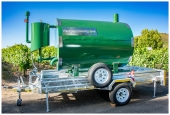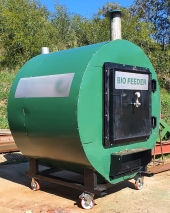Hi folks,
I'm in South Africa and my company BKI was recently appointed Sales Rep for a product now branded as the BIO FEEDER mobile pyrolysis unit. I've been looking for 11 years for a 'bona fide' Mobile Pyrolysis Unit and the BIO FEEDER checks all our boxes of what a Mobile Retort should represent in reality.

Capacity/Yield: The 3M3 mild steel barrel holds more than 1.3M3 (45 cub ft) of biomass and converts it into valuable products such as biochar, bio-oil and wood vinegar. The 1300+ litres retort volume translates to around 600 litres of lump biochar out. Then when crushed, produces approximately 250 to 300 litres of biochar. No need for quenching, so it’s very light and easy to work with. Expressed differently, 1000 kg of feedstock can produce a maximum of 250 kg (550 lbs) of biochar depending on type of feedstock, moisture content and particle size.
Wood Pellet Conversion: Special wire cages are being developed to accommodate “difficult” feedstock types such as wood pellets, shavings, sludge, bagasse, agri-waste such as Macadamia nut shells etc.
Wood Vinegar: Recent trials have produced 6 to 8 Litres of wood vinegar per burn cycle, depending on feedstock type and moisture content. The wetter the, the more wood vinegar is lost trough the stack.
Note: The weight of biomass can vary from softwood, hardwood logs to bamboo, and moisture content also varies. Depending on size of limbs and air gaps between branches it is better to talk in terms of volume only, and biochar can weigh more on a humid day. Often times clients prefer biochar to be mixed with water in order to inoculate it and protect the microorganisms so weight will vary. Due to the presence of water, and evaporation that occurs naturally and for the sake of consistency, biochar should never be sold on a weight basis.
Co-firing: It comes equipped with an LPG connection to start the fire in the firebox but LPG is just an optional extra ‘nice to have’.
Mobility: The unit comes on skids and castors can also be fitted. Trailer not supplied, but it fits on any 7 x 5 ft (2.1 x 1.5m) trailer. A trailer is available for purchase as an add-on.
License: The design is under international copyright
Support: The unit comes with an Operating Manual, Assembly instructions, Maintenance tips and a Run procedure.
International delivery / Export: We can export all over the world – see
https://www.instagram.com/biochar_kilns_int/ for more pictures.
This blog post contains a bit more information:
https://biocharkilns.com/2021/12/23/new-mobile-biochar-retort-south-africa/
Apologies for the blatant self promotion but we feel this tech needs to be spread far and wide. I have not been this excited about a product launch - ever.
That said thanks for reading this and do get in touch. Here's a video as well:
Kind regards
Kobus Venter













































